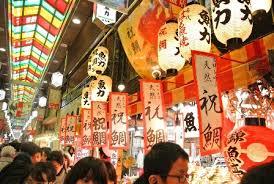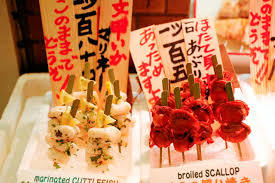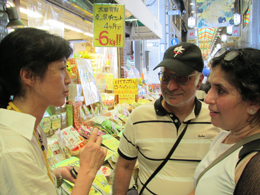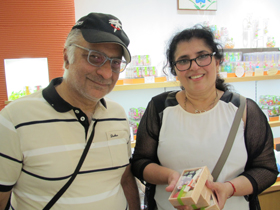Searching for Japanese Cooking Ingredients at Nishiki Food Market
 Known as the “kitchen of Kyoto,” the Nishiki Food Market shopping street has a history of 400 years. Its prosperity is said to have begun in 1615, when business as a fish market was approved by the Tokugawa shogunate. Although its role as a wholesale market ceased with the opening of the Kyoto Central Wholesale Market in 1927, even today there are 126 stores trading along a street stretching 390 meters east to west. Kyoto vegetables, pickles, salt-sweet preserves, dry foods, tofu, soy-milk skin—all of the essential ingredients in Kyoto cuisine can be obtained here.
Known as the “kitchen of Kyoto,” the Nishiki Food Market shopping street has a history of 400 years. Its prosperity is said to have begun in 1615, when business as a fish market was approved by the Tokugawa shogunate. Although its role as a wholesale market ceased with the opening of the Kyoto Central Wholesale Market in 1927, even today there are 126 stores trading along a street stretching 390 meters east to west. Kyoto vegetables, pickles, salt-sweet preserves, dry foods, tofu, soy-milk skin—all of the essential ingredients in Kyoto cuisine can be obtained here.  There are many delicatessen and confectionery stores, as well as restaurants, and tourists can be seen sampling food and eating lunches and snacks as they browse for souvenirs. Unusual ingredients, colorful confectionery, and other goods line the narrow spaces. The market is very popular among foreign travelers too, because it offers them a glimpse into the culture and cuisine of Kyoto. The store assistants are used to having foreign customers, and they can be heard explaining goods and recommending samples in broken English.
There are many delicatessen and confectionery stores, as well as restaurants, and tourists can be seen sampling food and eating lunches and snacks as they browse for souvenirs. Unusual ingredients, colorful confectionery, and other goods line the narrow spaces. The market is very popular among foreign travelers too, because it offers them a glimpse into the culture and cuisine of Kyoto. The store assistants are used to having foreign customers, and they can be heard explaining goods and recommending samples in broken English.
WAK Japan offers a Japanese cooking experience program in which participants go shopping in Nishiki Food Market and then use the ingredients they have bought to cook something. I accompanied the participants to see how they reacted.
 Mr. Himanshu Lakhani and his wife Arati, who are of Indian origin residing in Australia, were visiting Japan for 16 days. Following the wishes of Arati, who likes cultural things, as well as mainly Kyoto they were also going to such places as Hiroshima, Takayama, Ise, and Toba before finally returning home from Tokyo. In Kyoto they were planning to go to Arashiyama, watch a maiko show, and enjoy WAK Japan’s experience programs. As well as the stroll in Nishiki Food Market and Japanese cooking experience on that day, they had made reservations for calligraphy and origami classes too.
Mr. Himanshu Lakhani and his wife Arati, who are of Indian origin residing in Australia, were visiting Japan for 16 days. Following the wishes of Arati, who likes cultural things, as well as mainly Kyoto they were also going to such places as Hiroshima, Takayama, Ise, and Toba before finally returning home from Tokyo. In Kyoto they were planning to go to Arashiyama, watch a maiko show, and enjoy WAK Japan’s experience programs. As well as the stroll in Nishiki Food Market and Japanese cooking experience on that day, they had made reservations for calligraphy and origami classes too.
The WAK Japan guide, Ms. Yoko Akamizu, took them into various stores in the market and explained about ingredients of Japanese cooking that are especially unfamiliar to foreigners. She offered a wealth of information that foreigners cannot get just by walking around themselves, such as the types of pickles and how to make them and the flavor components and uses of kelp and dried bonito. The participants listened with great interest.
 Ms. Arati Lakhani said that she had many allergies, including meat and other protein, so she was very cautious about food and accepted samples only after verifying their contents. She liked the processed kudzu somen (noodles), which seem to blossom like flowers when deep-fried, and boxes of candies in the shape of hand-rolled sushi, which she bought as souvenirs.
Ms. Arati Lakhani said that she had many allergies, including meat and other protein, so she was very cautious about food and accepted samples only after verifying their contents. She liked the processed kudzu somen (noodles), which seem to blossom like flowers when deep-fried, and boxes of candies in the shape of hand-rolled sushi, which she bought as souvenirs.
Ms. Akamizu, the guide, also purchased some dried bonito shavings at a dry-food store, saying that they would be used in the cooking class later. How would they be used? This was certainly something not to be missed!